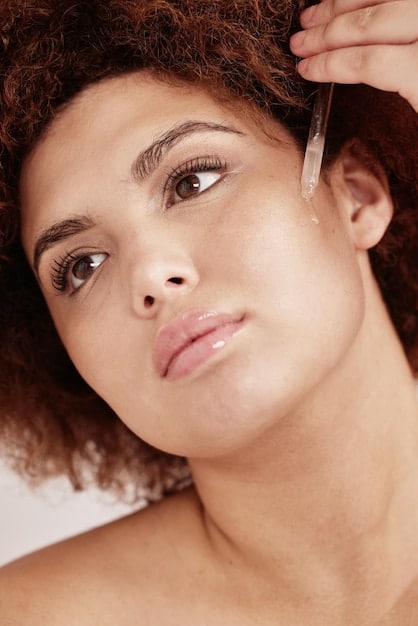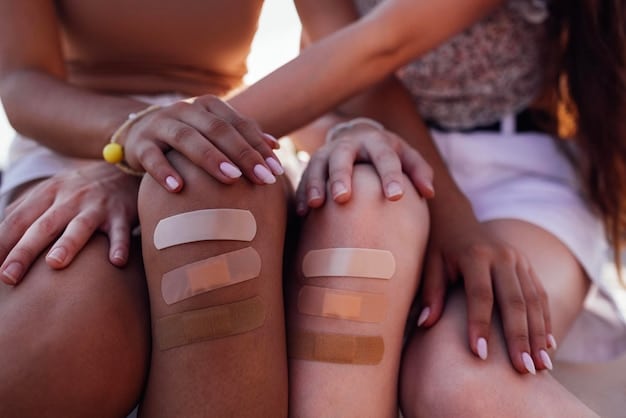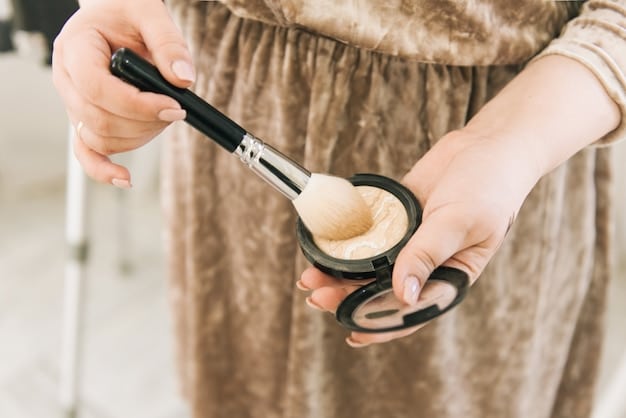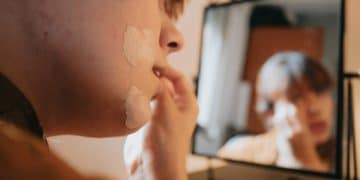Flawless Base Makeup: Ultimate Guide for Expert Application

Anúncios
Achieving a flawless makeup base involves a multi-step process, combining meticulous skin preparation, strategic product selection, and precise application techniques to create a smooth, even, and long-lasting canvas for any look.
Ever wondered how some people achieve that effortlessly perfect complexion that looks like a second skin? It’s not magic; it’s the art and science of perfecting your makeup base. This comprehensive guide, “The Ultimate Guide to Achieving a Flawless Base: Expert Tips and Tricks,” delves into every crucial step, from skin prep to setting, ensuring your makeup not only looks incredible but also lasts all day.
The Foundation of Flawlessness: Skin Preparation
A truly flawless base begins long before any makeup touches your skin. It starts with a well-maintained skincare routine that primes your canvas for optimal product adherence and wear. Neglecting proper skin preparation can lead to makeup caking, patchiness, and a lack of luminosity, undermining even the most expensive products.
Understanding your skin type is the first crucial step. Whether you have oily, dry, combination, or sensitive skin, tailoring your skincare routine to its specific needs will dramatically improve your makeup application. This personalized approach ensures your skin is balanced and ready to receive makeup beautifully.
Cleansing and Toning: The Initial Canvas
Start with a gentle yet effective cleanser to remove impurities, excess oil, and any remnants of previous makeup. Follow up with a toner to balance your skin’s pH levels and prepare it for subsequent treatments. This two-step process ensures a fresh, clean surface.
- 🧼 Use a pH-balanced cleanser suitable for your skin type.
- 💧 Apply toner immediately after cleansing to restore balance.
- 🚫 Avoid harsh toners that strip natural oils, especially for dry skin.
Hydration is Key: Moisturizers and Serums
Hydration is paramount for a smooth makeup application. A well-moisturized skin surface allows foundation to glide on seamlessly, preventing dry patches and enhancing a dewy finish. Serums, when incorporated, can address specific concerns like hyperpigmentation or fine lines, further refining your canvas.
Choosing the right moisturizer is essential. For oily skin, opt for oil-free or gel-based formulas. Dry skin benefits from richer, cream-based moisturizers. Always allow your moisturizer to fully absorb before moving to the next step, typically 5-10 minutes, to prevent makeup pilling.
Priming for Perfection: Selecting the Right Base
Primers act as a crucial link between your skincare and makeup, creating an ideal surface for foundation application and extending its wear. Far from being a mere luxury, a good primer can address various skin concerns, from minimizing pores to brightening dull complexions, making them an indispensable part of a flawless base routine.
The market is flooded with primers, each formulated to tackle specific issues. Understanding these variations is key to selecting the one that best suits your needs, ensuring your base looks impeccable and lasts longer, transforming an ordinary application into something extraordinary.
Understanding Primer Types and Their Benefits
Different primers cater to different concerns. A hydrating primer, for instance, is perfect for dry skin, preventing foundation from settling into fine lines. A mattifying primer controls oil and shine, ideal for oily skin types, while a color-correcting primer can neutralize redness or dullness, providing an even tone.
- ✨ **Hydrating Primers:** Infuse moisture, ideal for dry or dehydrated skin, providing a dewy finish.
- ⚪ **Mattifying Primers:** Control excess oil and shine, keeping makeup fresh for combination to oily skin.
- 🌈 **Color-Correcting Primers:** Neutralize discoloration (redness, sallowness) for a more even skin tone.
- 🌟 **Blurring/Pore-Filling Primers:** Minimize the appearance of pores and fine lines, creating a smoother texture.
Application Techniques for Optimal Prime
Apply primer sparingly, focusing on areas where you need it most. For example, a mattifying primer might be concentrated on the T-zone, while a blurring primer can be applied to areas with visible pores. Use your fingertips to gently pat the primer onto the skin, allowing it to fully absorb before applying foundation.
Allowing the primer to set for a few minutes is crucial. This creates a tacky surface that helps foundation adhere better, preventing it from sliding off or caking. Patience at this stage pays dividends in the longevity and finish of your overall makeup look.
The Art of Foundation: Matching and Application
Foundation is the cornerstone of a flawless base, responsible for evening out skin tone and creating a uniform complexion. However, choosing the right shade and formula, along with mastering its application, can be daunting. The goal is a second-skin finish, not a mask-like appearance.
The sheer variety of foundation formulas—liquid, cream, powder, stick—means there’s a perfect match for everyone. Understanding the nuances of each and how your skin reacts to them is vital for achieving that coveted natural, yet perfectly polished, look we all strive for.
Finding Your Perfect Shade and Undertone
Matching your foundation shade involves more than just finding the closest color. Understanding your skin’s undertone—warm, cool, or neutral—is critical. Test shades on your jawline in natural light to see how they blend seamlessly into your neck and face. A perfect match virtually disappears.

- 🌞 **Warm Undertones:** Skin has golden, peachy, or yellow hues.
- ❄️ **Cool Undertones:** Skin has pink, red, or bluish hues.
- ⚖️ **Neutral Undertones:** A balance of warm and cool tones.
Choosing the Right Formula: Liquid, Cream, or Powder
Liquid foundations offer versatility, from sheer to full coverage, and are suitable for most skin types. Cream foundations provide higher coverage and a dewy finish, often preferred for dry or mature skin. Powder foundations are excellent for oily skin, offering a matte finish and quick application.
Consider the finish you desire: luminous, natural, demi-matte, or matte. A luminous finish is ideal for dry skin seeking a youthful glow, while a matte finish provides oil control for combination to oily skin. The formula should complement your skin type and your desired aesthetic for harmonious results.
Application Techniques: Brushes, Sponges, or Fingers
The tool you use can significantly impact your foundation’s finish. Brushes offer precision and varying coverage levels depending on their density. Sponges, when damp, provide a natural, airbrushed finish by gently pressing the product into the skin. Fingers warm the product, allowing for a sheer, natural application.
Regardless of your chosen tool, apply foundation in thin layers, building up coverage where needed. Begin in the center of your face and blend outwards, ensuring no harsh lines are visible, especially around the jawline and hairline, for a truly seamless transition.
Concealing Imperfections: Strategic Spot Treatment
Concealer is your secret weapon for perfecting your base, addressing specific imperfections that foundation alone might not fully cover. From dark circles to blemishes and redness, strategic concealer application can transform your complexion, creating an illusion of flawless skin without looking heavy.
The key to successful concealing lies in choosing the right type of concealer and applying it precisely. Over-application can draw more attention to the area, while the wrong shade can highlight rather than hide, underscoring the importance of informed product selection and technique.
Choosing the Right Concealer for Different Concerns
For undereye circles, opt for a creamy, hydrating concealer one shade lighter than your foundation to brighten the area. For blemishes, use a full-coverage, opaque concealer that matches your skin tone perfectly to camouflage without drawing attention. Color correctors can be employed before concealer for severe discoloration.
- 💡 **Under-eye Concealer:** Lighter, hydrating, often peachy or salmon-toned to counteract blue/purple.
- 🎯 **Blemish Concealer:** Matches skin tone, high coverage, often thicker consistency.
- 🔴 **Redness Concealer:** Green-tinted to neutralize red areas.
Application Techniques for Undereyes and Blemishes
For undereyes, apply concealer in an inverted triangle shape to brighten and lift the entire area, not just directly under the eye. Gently blend with a damp sponge or your ring finger. For blemishes, dab a small amount directly onto the imperfection and lightly feather the edges into the surrounding foundation.
Set your concealer immediately, especially under the eyes, to prevent creasing. A light dusting of translucent setting powder applied with a small, fluffy brush will lock it in place, ensuring long-lasting coverage and a smooth finish throughout your day.
Setting Your Masterpiece: Powders and Sprays
After carefully applying your foundation and concealer, the final step in creating a truly flawless base is setting it. This crucial stage locks everything in place, extends wear time, controls shine, and ensures your makeup looks fresh and polished for hours, preventing smudging or fading throughout the day.
Setting products come in various forms, each with unique benefits. Understanding the differences between loose powders, pressed powders, and setting sprays, and knowing when and how to use them, is essential for achieving a durable and beautifully finished complexion that stands the test of time.
The Power of Setting Powders: Loose vs. Pressed
Loose setting powders are ideal for baking undereyes and T-zones, providing a soft-focus, matte finish and significantly extending wear. Pressed powders are great for touch-ups on the go, offering light coverage and quick shine control without disturbing your base makeup.
- 🌬️ **Loose Powder:** Fine texture, excellent for baking and overall setting, creates a soft, diffused look.
- compactness, convenient for touch-ups, offers light coverage and shine absorption.
Strategic Powder Application for Longevity
Apply setting powder sparingly, focusing on areas prone to oiliness, such as the T-zone, and under the eyes to prevent creasing. Use a fluffy brush for a light dusting or a damp sponge for a ‘baking’ technique in specific areas. Always press, rather than sweep, the powder into the skin for optimal lock-in.
Avoid over-powdering, which can lead to a cakey or flat appearance. The goal is to set your makeup without stripping away its natural luminosity or texture. A light hand will ensure your skin still looks like skin, but with enhanced longevity and a perfected finish.

Finishing Touches: Setting Sprays
Setting sprays are the ultimate finishing touch, melting all layers of makeup together for a seamless look and significantly increasing wear time. They come in various finishes—matte, dewy, or natural—to complement your desired look, providing a protective barrier against external elements.
Hold the setting spray at arm’s length and mist your face in a “T” and “X” motion, allowing it to dry naturally. This not only sets your makeup but can also refresh your complexion and remove any powdery finish, granting your base a fresh, natural appearance that lasts from dawn till dusk.
Common Pitfalls and Pro Solutions for a Flawless Base
Even with the best products, achieving a flawless base can present challenges. Common issues like caking, patchiness, and makeup breakdown can frustrate anyone. Understanding these problems and having an arsenal of expert solutions can help overcome them, ensuring your base always looks its best.
Many of these pitfalls stem from incorrect product application or an incomplete understanding of how different products interact with each other and with your skin. Identifying the root cause is the first step toward rectifying the issue and mastering your flawless base routine.
Addressing Caking and Creasing
Caking often results from applying too much product, particularly foundation or powder. Creasing is common under the eyes due to product settling into fine lines. To combat caking, apply thin layers and blend thoroughly. For creasing, use less product, hydrate the area well, and set with a minimal amount of powder.
Using a damp sponge for foundation application can help press product into the skin rather than layering it on top, reducing the likelihood of caking. For under-eye creasing, the “baking” technique, followed by brushing away excess powder, can significantly smooth the appearance.
Preventing Patchiness and Uneven Application
Patchiness usually indicates dry or dehydrated skin, or a lack of proper exfoliation. Ensure your skin is well-moisturized and consider incorporating gentle exfoliation into your skincare routine to remove dead skin cells. Apply foundation evenly, blending well into all areas of the face and neck.
- 💧 Ensure skin is fully hydrated before makeup application.
- 🧴 Use a primer to create an even surface and grip for foundation.
- 🔄 Blend foundation thoroughly with chosen tool, avoiding streaks.
- ✨ Exfoliate regularly to prevent dry patches from appearing on the skin.
Tackling Makeup Breakdown and Oiliness
Makeup breakdown, especially in oily areas, can be frustrating. This often happens when skin produces excess oil, causing foundation to separate. Using a mattifying primer and an oil-controlling foundation can help. Blotting papers are excellent for absorbing excess oil throughout the day without disturbing makeup.
Setting your face with a mattifying setting powder and a long-wear setting spray will further lock your makeup in place, inhibiting breakdown. If oiliness becomes an issue, gently blot the shine away and re-dust with a minimal amount of pressed powder in affected areas for a quick refresh.
Mastering Longevity: Making Your Flawless Base Last
Achieving a flawless base is one thing; making it last throughout the day, through varying conditions, is another challenge entirely. Longevity is key to a truly successful makeup look, preventing the need for constant touch-ups and ensuring you remain confident from morning till night. This involves a combination of product choices and strategic application techniques.
The interaction between your skin type, environmental factors, and product formulas all play a significant role in how well your makeup withstands wear. By adopting smart practices, you can dramatically extend the life of your beautifully applied base, keeping it looking fresh and perfected for hours on end.
Layering Products for Extended Wear
Layering is a fundamental technique for longevity. Start with a long-wearing primer, followed by a foundation formulated for extended wear. Set liquid and cream products with powders, and then lock everything in with a robust setting spray. Each layer adds to the overall durability of your base.
Consider using waterproof or water-resistant formulas for special occasions or humid climates. These products are designed to withstand moisture and sweat, ensuring your flawless base remains untouched, even under challenging conditions, offering peace of mind and unwavering perfection.
Touch-Up Essentials for On-the-Go Perfection
Even the most perfectly applied and set base might require minor touch-ups throughout a long day. Keeping a few essentials in your bag can make all the difference. Blotting papers are invaluable for absorbing excess oil without adding more product, preserving your matte or natural finish.
- blotting papers to absorb oil without disturbing makeup.
- Compact pressed powder for quick, light touch-ups on shiny areas.
- A small, dense brush or puff for precise powder application.
- Lip balm or lip tint to revive your overall look and feel fresh.
Environmental Factors and Product Choices
Humidity and heat can cause makeup to melt or slide. In such conditions, opt for lighter-weight, oil-free formulas and focus on matte finishes. Cold and dry environments can lead to increased dehydration and patchiness; in these cases, prioritize hydrating primers and dewy foundations.
Adapting your base routine to the climate is crucial. What works perfectly in a moderate environment might fail in extreme conditions. By making informed choices about your products based on upcoming weather and your daily activities, you can ensure your flawless base remains intact, reflecting your desired look effortlessly.
| Key Point | Brief Description |
|---|---|
| 🧴 Skin Prep | Cleanse, tone, and moisturize to create a smooth canvas, vital for seamless makeup application. |
| ✨ Primer Match | Select primers based on skin concerns (e.g., hydration, mattifying, blurring) for optimal base grip. |
| 🎨 Foundation & Concealer | Match undertone and formula. Apply strategically for even tone and targeted imperfection coverage. |
| 🔒 Setting & Longevity | Set with powders and sprays to lock in makeup, ensuring extended wear and a flawless finish. |
Frequently Asked Questions About Flawless Bases
Skin type is absolutely critical when choosing foundation. Oily skin benefits from matte, oil-free formulas, while dry skin thrives with hydrating, luminous foundations. Combination skin might need a mix or a balanced formula, and sensitive skin requires gentle, non-irritating options. Matching your foundation to your skin type prevents common issues like caking or excessive shine, ensuring a flawless and comfortable wear throughout the day.
While long-wearing foundations are designed for durability, skipping primer is generally not recommended for a truly flawless and extended base. Primer creates an ideal canvas, addressing specific concerns like pores, fine lines, or oil control that foundation alone cannot. It also helps foundation adhere better, preventing it from slipping or caking, and can enhance the overall smoothness and longevity of your makeup significantly.
The best way to match your foundation shade is by testing it directly on your jawline, not your hand or arm, in natural light. Allow it to oxidize for a few minutes before assessing. Look for a shade that seamlessly blends into both your face and neck without creating a noticeable line. Understanding your undertone (warm, cool, or neutral) is also crucial for a perfect, natural-looking match that complements your overall complexion and avoids a mask-like appearance.
To prevent under-eye concealer from creasing, ensure the area is well-hydrated before application. Use a thin layer of a hydrating, less-is-more formula. Gently blend with your ring finger or a damp sponge, pressing the product into the skin. Crucially, immediately set the concealer with a very thin dusting of a finely milled translucent powder using a small, fluffy brush, lightly pressing it into the skin to lock it in place without adding bulk.
While not strictly necessary for every makeup look, setting spray is highly recommended for achieving maximum longevity and a truly flawless finish. It melts powders into the skin, preventing a cakey appearance, and creates a protective barrier that locks makeup in place. Setting sprays significantly extend wear time, control shine, and ensure your base remains fresh and vibrant throughout the day, especially beneficial for long events or challenging weather conditions.
Conclusion
Achieving a flawless makeup base is a transformative process, elevating your entire look from ordinary to extraordinary. It’s a testament to the power of meticulous preparation, informed product selection, and precise application. From adequately preparing your skin with a tailored skincare routine to strategically choosing and applying primers, foundations, and concealers, every step contributes to the final masterpiece. By understanding the nuances of how products interact with your skin and employing expert techniques for setting and longevity, you can confidently create a durable, radiant canvas that enhances your natural beauty. Embrace these tips and tricks, and unlock the secret to a base that not only looks impeccable but feels like a second skin, empowering you to face any day with renewed confidence and effortless grace.





